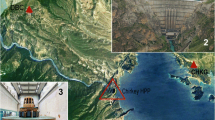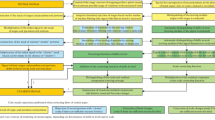Abstract
We describe a new prototype of a remote station for the continuous measuring of geoelectrical parameters in seismic active areas. The design of the monitoring equipment combines advanced technologies for electrical sensors with robust statistical methodologies for the identification of anomalous patterns in the recorded signals, possibly related to local seismic events. The main features of the remote station have been highlighted analyzing the data measured in a seismic active area of Southern Apennine chain (Italy). An acquisition unit operating with a 24 bit A/D converter controls a multi-electrode array equipped with sensors able to detect the temporal fluctuations of electrical field on the earth surface. In a first step, we have developed a software package able to check those factors that can contaminate the electrical parameters, such as the rainfall events. In a second step, we investigated the inner dynamical structure of the measured data at different time scales; then, it has been verified that the temporal fluctuations of the electrical signals are well described by a first-order autoregressive process.
Taking into account the quantitative dynamics extracted by the geoelectrical time series, we began to study the so-called extreme events (or runs), i.e., that consecutive values above/below a fixed threshold with a low occurrence probability. Finally, we attempted to identify such events and to study their correlation with the seismic phenomena observed in the investigated area.
Similar content being viewed by others
References
Geller, R.J. (Ed.), 1996, Special Issue on “Debate on VAN method”: Geophys. Res. Lett., v. 11, p. 23.
Evans, R. (Ed.), 1997, Special Issue on “Assessment of schemes for earthquake prediction”: Geophys. J. Int., v. 131.
Johnston, M.J.S., 1997, Review of electric and magnetic fields accompanying seismic and volcanic activity: Surveys in Geophysics, v. 18, p. 441–475.
Geller, R.J., Davis, D., Kagan, Y.Y., and Mulargia, F., 1997, Earthquakes cannot be predicted: Sciences, v. 275, p. 1616–1617.
Cuomo, V., Di Bello, G., Lapenna, V., Piscitelli, S., Telesca, L., Macchiato, M., and Serio, C., 2000, Robust statistical methods to discriminate extreme events in geoelectrical precursory signals: implication with earthquake prediction: Natural Hazard, v. 21, p. 247–261.
Nature debate, 1999. Is the reliable prediction of individual earthquakes a realistic scientific goal?. http://helix.nature.com/debates/earthquake/.
Cuomo, V., Lapenna, V., Macchiato, M., Marson, I., Paparo, G., Patella, D. and Piscitelli, S., 2000, Geoelectrical and Seismoacoustic Anomalous Signals Jointly Recorded Close to an Active Fault System in Southern Apennines (Italy): Phys. Chem. Earth, v. 20, no. 3, p. 255–261.
Nur, A., 1972, Dilatancy, pore fluids, and premonitory variations of ts/tp travel times. Bulletin of the seismological Society of America, v. 62, no. 5, p. 1217–1222.
Scholz, C. H., 1990, The mechanics of earthquakes and faulting: Cambridge University Press, p. 439.
Di Maio, R. and Patella, D., 1991, Basic theory of electrokinetic effects associated with earthquakes. Bollettino di Geofisica teorica ed applicata, v. 33, p. 130-131, p. 145–154.
Park, S. K., 1996, Precursors to earthquakes: seismo-electromagnetic signals: Survey in Geophysics, v. 17, p. 493–516.
Vallianatos, F. and Tzanis, A., 1998, Electric current generation associated with deformation rate of a solid: Preseismic and coseismic signals: Physics and Chemistry of the Earth, v. 23, no. 9, p. 933–938.
Pantosti, D. and Valensise, G., 1990, Faulting mechanism and complexity of the November 23, 1980, Campania Lucania earthquake, inferred from surface observations: J. Geophys. Res., v. 95, no. B10, p. 15329–15341.
Ekström, G., 1994, Teleseismic analysis of the 1990 and 1991 earthquakes near Potenza: Ann. Geofis., v. 37, no. 6, p. 1591–1599.
Patella, D., Tramacere, A., and Di Maio, R., 1997, Modelling earth current precursors in earthquake prediction: Ann. Geofis., v. XL, no. 2, p. 495–517.
Ishido, T. and Mizutani, H., 1981, Experimental and theoretical basis of electrokinetic phenomena in rock-water systems and its applications to geophysics: J. Geophys. Res., v. 86, p. 1763–1775.
Morgan, F., Williams, E., and Madden, T., 1989, Streaming potential properties of west-erly granite with applications: J. Geophys. Res., v. 94, p. 12,449-12,461.
Revil, A., Glover, P.W.J., and Pezard, P.A., 1999a, Streaming potential in porous media. 1. Theory of the zeta potential: J. Geophys. Res., v. 104, no. B9, p. 20021–20031.
Revil, A., Cathles, L.M. III, Manhardt, P.D., and Schwaeger, H., 1999b, Streaming potential in porous media. 2. Theory and application to geothermal systems: J. Geophys. Res., v. 104, no. B9, p. 20033–20048.
Cuomo, V., Di Bello, G., Lapenna, V., Macchiato, M. and Serio, C., 1996, Parametric time series analysis of extreme events in electrical earthquake precursors: Tectonophysics, v. 262, p. 159–172.
Box, G.E.P. and Jenkins, G.M., 1976, Time Series Analysis: Holden-Day, San Francisco.
Di Bello, G., Lapenna, V., Satriano, C., and Tramutoli, V., 1994, Self-potential time series analysis in a seismic area of Southern Apennines: preliminary results: Ann. Geofis., v. 37, p. 1137–1148.
Colangelo, G., Lapenna, V., Vallianatos, F., and Nomikos, C., 2000, Investigating the time dynamics of geoelectrical signals measured in two seismotectonic environments in the Mediterranean region: the Southern Apennine chain (Southern Italy) and the Hellenic arc (Crete Island, Greece): Annali di Geofisica, v. 43, no. 2: p. 391–408.
Kendall, M. and Stuart, A., 1977, The advanced theory of statistics: Charles Griffin and Company Limited, London.
Cramer, H. and Leadbetter, M.R., 1967, Stationary and related stocastic processes: Wiley, Chichester, p. 348.
Cuomo, V., Lapenna, V., Macchiato, M., and Serio, C., 1997, Autoregressive models as a tool to discriminate chaos from randomness in geoelectrical time series: an application to earthquake prediction: Ann. Geofis., v. 40, no. 2, p. 385–399.
Benderitter, Y. and Schott, J.J., 1999, Short time variation of the resistivity in an unsaturated soil: the relationship with rainfall: Europ. Env. and Eng. Geophys., v. 4, p. 37–49.
Gallipoli, M.R., 1999, Monitoraggio sismico con stazioni digitali ad alta risoluzione: primi risultati: Technical Report, no. 7/99.
Dobrovolsky, I. P., 1993, Analysis of preparation of a strong tectonic earthquake. Physics of the Solid Earth, v. 28, no. 6, p. 481–493.
Author information
Authors and Affiliations
Rights and permissions
About this article
Cite this article
Balasco, M., Chianese, D., Lapenna, V. et al. A New Prototype of a Remote Station for the Monitoring of Geoelectrical Parameters in Seismic Active Areas. Subsurface Sensing Technologies and Applications 3, 35–57 (2002). https://doi.org/10.1023/A:1014058229309
Issue Date:
DOI: https://doi.org/10.1023/A:1014058229309




